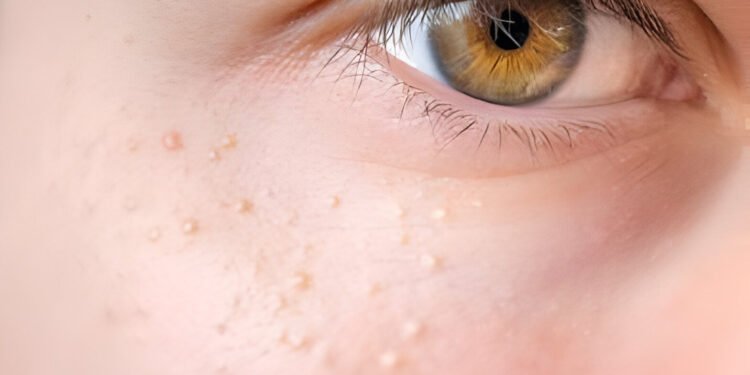Milialar is a preferred term in Turkey generally called Milia. It defines tiny, pearl-like cysts that normally appear on the skin around the eyes, specifically on the eyelids. Although these little bumps are generally safe, they can be difficult because of their look. It is very important to keep in mind that milialar is not a type of acne. In this detailed overview, we will delve into the world of milialar or milia, exploring its types, growth, indications, symptoms, safety nets, and treatment choices. The information supplied is based upon substantial scientific study and professional understanding of milia, guaranteeing you have a detailed understanding of this condition.
Contents
- 1 What is Milia or Milialar?
- 1.1 Related posts
- 1.2 Naturopathy: Harnessing the Body’s Natural Healing Power
- 1.3 Comprehensive Alternative Cancer Treatments at VeritaLife: A Personalized Approach
- 1.4 Unveiling the Potential of Chelation Therapy: A Comprehensive Overview
- 1.5 Alternative Cancer Treatments: A Comprehensive Overview
- 1.6 Why You Should Try Stem Cell Therapy
- 1.7 Exercise With Oxygen Therapy (EWOT): A Revolutionary Approach to Health Enhancement
- 1.8 Top Tips for a Balanced Lifestyle
- 2 Kinds of Milia or Milialar
- 3 Milia or milialar include:
- 4 Second Milia or Milialar
- 5 What Causes Milia or Milialar Development?
- 6 Therapy Options for Milia or Milialar
What is Milia or Milialar?
Milialar are tiny, dome-shaped bumps that normally range in size from 1-2 millimeters, about the dimension of a pinhead. They look like whitish-yellow, pearly cysts with a firm and smooth structure on the skin surface. One of the most common locations is milia on the eyelid and the skin under the eyes, where they appear like small pearls embedded under the skin. According to research, milia occurs when keratin, a healthy protein discovered in the skin, hair, and nails, becomes trapped beneath the skin’s surface. While they are commonly seen in babies, grownups can additionally establish milia, frequently as a result of skin damage.
Kinds of Milia or Milialar
Milia can be categorized right into 2 primary kinds: Main Milia and Second Milia Primary Milia or Milia. Key milia are straight-formed due to the entrapment of keratin within the skin. They are a lot more generally seen in neonates due to premature sweat air ducts.
Milia or milialar include:
Small, white-to-yellow cysts- frequently located on the face, especially on the cheeks, nose, and around the eyes. Usually asymptomatic- Commonly deals spontaneously in infants within a few weeks to months.
Second Milia or Milialar
Secondary milia, on the other hand, develop as a result of trauma or injury to the skin. They can happen in adults after certain skin conditions or procedures. Key qualities of secondary milia or milia consist of:
Comparable look to key milia, typically seen in areas where an injury or procedure happened. Signs could be connected with the underlying cause, such as pain from a burn. The period varies and can linger longer depending on the cause. Dealing with the underlying cause is vital, and treatments like manual removal, laser therapy, or medications might be thought about. Read hair makeup, skin care, and more information here – Skin Care.
What Causes Milia or Milialar Development?
Milialar forms when dead skin cells come to be entrapped under the skin’s surface area, causing the development of small cysts. While they often appear on the face, specifically around the eyes and cheeks, they can additionally happen elsewhere on the body. Several elements add to the advancement of milia or milialar, although the underlying trigger is not always recognizable. These elements consist of:
- Genetics: Some people have a genetic tendency for developing milia, and it typically runs in households.
- Sun Exposure: Extended sunlight exposure can harm facial skin over time, increasing the danger of milia.
- Skin Injury: Injury to the skin, such as cuts, burns, abrasions, and blisters, may result in the development of milia throughout the recovery procedure.
- Specific Medical Conditions: Disorders that create completely dry skin and inflammation, like eczema, can enhance the danger.
- Medications: Some medicines, like steroids, may promote milia as an adverse effect.
- Heavy Creams and Make-up: Using thick, greasy products can block pores and trigger cysts.
Therapy Options for Milia or Milialar
For the most part, milia does not call for treatment, and lots of resolve spontaneously within weeks to months. Nevertheless, if the bumps linger or cause distress, a number of therapy choices are available:
- Prescription Retinoid Creams: Creams including tretinoin, adapalene, or tazarotene can aid dry and sloughing off the milia.
- Microdermabrasion: This strategy makes use of fine crystals to carefully scrub the external skin layers and boost healing.
- Chemical Peels: Using a mild glycolic or salicylic acid option aids in softening and getting rid of the lesions.
- Electrocautery: This entails burning off the milia with a hyfrecator cauterizing tool while making use of an anesthetic.
- Guidebook Extraction: A skin doctor can open the cyst with a sterilized needle and eject the materials.
- Cryotherapy: Freezing the bumps with fluid nitrogen to remove the lesions.
- Laser Ablation: Using laser energy to damage the cysts.
- Surgical Elimination: In some cases, a skin specialist may choose medical elimination by cutting open and draining the milia, often requiring stitches.
Conclusion
The small pearl-like cysts that can turn up on the skin, are generally safe and can be situated on the eyelids and around the eyes. While they are a great deal more common in babies, adults can additionally develop them, generally as a result of skin damage. Milia is available in different types, and their growth is affected by numerous aspects, consisting of genetics, sun direct exposure, skin trauma, medical problems, medications, and the use of whipping creams and make-up.
If you have milia and they cause you distress, there are various treatment options offered, although several instances resolve naturally. To avoid milia, it’s necessary to adopt correct skincare techniques, prevent hefty cosmetics, no make-up, and shield your skin from excessive sunlight direct exposure.
FAQs
Q1. What is milia?
Ans. Milia are tiny, white, or yellowish bumps that commonly appear on the skin, especially on the face. They happen when keratin, a healthy protein located in the skin, comes to be trapped under the surface, creating tiny cysts.
Q2. What triggers milia?
Ans. Milia can be brought on by different elements, including skin trauma such as burns or sunlight damage, use of hefty skin care products, specific drugs, and hereditary predisposition. They can likewise create newborns, known as neonatal milia, and typically settle on their own.
Q3. How to avoid milia?
Ans. To aid protect against milia, it is necessary to stay clear of utilizing heavy or comedogenic skincare items that can block pores. Routine peeling can additionally aid in eliminating dead skin cells, lowering the chance of milia formation. In addition, shielding your skin from sunlight damage with sunscreen can be advantageous.
Q4. Is Milia damaging?
Ans. In many cases, milia are harmless and do not cause any kind of discomfort or discomfort. Nevertheless, they can be visually disappointing for some people. If milia is swollen or contaminated, it’s essential to speak with a dermatologist for proper assessment and therapy.


















